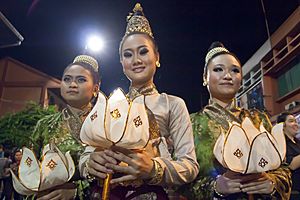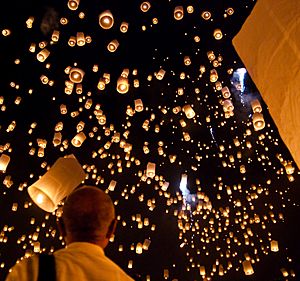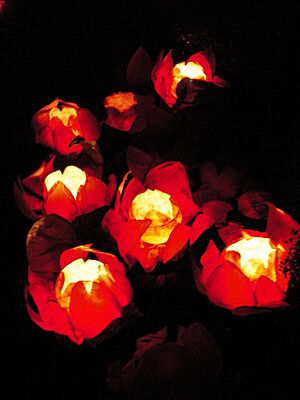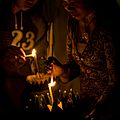Loy Krathong facts for kids
Quick facts for kids Loy Krathong |
|
|---|---|

Floating krathong in Chiang Mai
|
|
| Official name | Loy Krathong |
| Observed by | Thailand, Laos (as Boun That Luang), northern Malaysia, Shan in Myanmar and Xishuangbanna in China, Myanmar (as Tazaungdaing festival), Sri Lanka (as Il Poya), China (as Lantern Festival), Cambodia (as Bon Om Touk) |
| Type | Asian |
| Significance | Worship and ask for forgiveness to Goddess of water Ganga, worship the Buddha's hair pagoda in the heaven |
| Date | Full moon of the 12th Thai month |
| Frequency | Annual |
| Related to | Tazaungdaing festival (in Myanmar), Mid-Autumn Festival (in China), Bon Om Touk (in Cambodia), Il Poya (in Sri Lanka), Boita Bandana (in Odisha, India) |
Loy Krathong (Thai: ลอยกระทง) is a beautiful festival celebrated every year in Thailand. It is also enjoyed in nearby countries like Laos and parts of Myanmar. The name "Loy Krathong" means "to float a ritual vessel or lamp." This comes from the tradition of making special decorated baskets called krathong. People then float these krathong on rivers and canals. Many Thais float krathong to thank the Water Goddess, Phra Mae Khongkha. They also do it to honor the Buddha's hair pagoda in heaven. This festival has roots in both Indian and Chinese traditions.
Loy Krathong happens on the evening of the full moon. This is during the 12th month of the traditional Thai lunar calendar. So, the exact date changes each year. In Western calendars, it usually falls in November. In Chiang Mai, a city in Thailand, the festival can last for three days.
This festival is known by different names outside Thailand. In Myanmar, it is called the "Tazaungdaing festival". In Sri Lanka, it's "Il Full Moon Poya". China celebrates it as the "Lantern Festival", and Cambodia calls it "Bon Om Touk".
Contents
What is Loy Krathong?

A krathong is a small floating container. It is traditionally made from leaves. These containers are designed to hold small items. For the festival, krathong are often made from a slice of a banana tree trunk. They can also be made from a spider lily plant.
Today, many krathong are made from bread. These bread krathong break down in the water. Fish can even eat them! Banana stalk krathong are also good for the environment. They are biodegradable, meaning they naturally break down. However, krathong made from Styrofoam are now often banned. This is because Styrofoam pollutes rivers and oceans.
Each krathong is beautifully decorated. They have folded banana leaves, three incense sticks, and a candle. Sometimes, a small coin is placed inside. This coin is an offering to the spirits of the river. On the night of the full moon, people launch their krathong. They float them on a river, canal, or pond. As they do this, they make a wish.
Large, decorated krathong are launched by government offices and other groups. There are even competitions for the best ones. Beauty contests are also a common part of the celebrations. Fireworks often light up the sky during the festival.
Where Did Loy Krathong Come From?
Loy Krathong might have started in Angkor Thom in the Khmer Empire. Pictures on the walls of the Bayon temple show scenes similar to Loy Krathong. This temple was built in the 12th century. One carving shows a queen floating a krathong on the river. Other royal women are shown holding krathong by the riverbank. This is much like the tradition seen today in Southeast Asian countries.
Many people now believe Loy Krathong in Thailand combines three festivals. These are the Bondet Bratib from the Khmer Empire, the Water Lantern festival from China, and the Kartik Purnima festival from India. The Indian festival is called Boita Bandana. It is celebrated on the full moon day of the Kartik month. This month is usually in October or November. Loy Krathong celebrations happen around the same time. Ancient Kalinga (part of modern Odisha, India) had strong trade links with Southeast Asia. This might explain why these festivals are so similar.
Meaning of the Name
The word loi (ลอย) means 'to float'. The word krathong (กระทง) has several meanings. One meaning is 'a small vessel made of leaves that can be floated on water'.
Some experts believe krathong comes from an Old Chinese word. This word means 'ritual vessel' or 'lamp'. Others think it comes from the Khmer language word kantong. This Khmer word sounds similar and has the same meaning.
History of the Festival
Early Legends
A popular story says Loy Krathong began in the Sukhothai Kingdom. It was supposedly started by a lady named Nopphamat. However, this story comes from a poem written much later.
In 1863, King Rama IV wrote about the festival. He said it was originally a Hindu festival. Over time, Thai Buddhists adapted it. They began to celebrate it to honor the Buddha. The candle in the krathong represents light for the Buddha. Floating the krathong away symbolizes letting go of bad feelings. These include hatred, anger, and other negative thoughts.
Sometimes, people cut their fingernails or hair. They place these clippings on the krathong. This is another way to symbolize letting go of past mistakes and bad thoughts. Many Thais also use the krathong to thank the Water Goddess, Phra Mae Khongkha.
Mentions in History
A French ambassador named Simon de la Loubère visited Thailand in 1687. He wrote a book about his travels. In his book, he described the Loy Krathong festival. He mentioned how the river would be covered with floating lanterns. These lanterns were of different sizes and colors. He also described how people would decorate their homes and palaces with lights. This was to thank the Earth for the harvest.
Modern Celebrations
The beauty contests held during Loy Krathong are called "Nopphamat Queen Contests." These contests became popular during the reign of King Rama III. After many wars, the country became peaceful. King Rama III wanted to bring back important festivals. So, he encouraged people to celebrate Loy Krathong.
The legend of Nang Nopphamat (Thai: นางนพมาศ) says she was a queen of a 13th-century Sukhothai King. She was said to be the first to float a decorated raft. However, this story might have been made up in the early 1800s. There is no proof that Nang Nopphamat ever lived. Instead, she was a character in a novel from around 1850. Her character was meant to guide women who wanted to work for the government.
Loy Krathong is also celebrated in Kelantan, Malaysia. The Malaysian tourism ministry sees it as a tourist attraction.
Yi Peng Festival

Loy Krathong happens at the same time as the Lanna (northern Thai) festival called Yi Peng (Thai: ยี่เป็ง). Yi means 'two' and peng means 'full moon day'. So, Yi Peng means the full moon day in the second month of the Lanna calendar. This festival is a time for people to make merit, which means doing good deeds.
During Yi Peng, many sky lanterns (Thai: โคมลอย; khom loi) are launched into the air. These 'floating lanterns' are made from thin fabric like rice paper. They are stretched over a bamboo or wire frame. A candle or fuel cell is attached to the frame. When the fuel cell is lit, hot air fills the lantern. This hot air makes the khom loi float up into the sky.
People also decorate their homes, gardens, and temples with khom fai (Thai: โคมไฟ). These are paper lanterns with detailed shapes. There are different types:
- Khom thue (Thai: โคมถือ) are lanterns carried on a stick.
- Khom khwaen (Thai: โคมแขวน) are hanging lanterns.
- Khom pariwat (Thai: โคมปริวรรต) are placed at temples. They spin around because of the heat from the candle inside.
The biggest Yi Peng celebrations are in Chiang Mai. This city was once the capital of the Lanna kingdom. Now, both Loy Krathong and Yi Peng are celebrated there together. This creates a beautiful sight with lights floating on water, hanging from trees, and rising into the sky. The Yi Peng tradition was also adopted in parts of Laos in the 16th century.
After the Festival
After Loy Krathong, cities work to clean up the waterways. In 2016, the Bangkok Metropolitan Administration collected six tonnes of rubbish. This rubbish came from the city's rivers and canals. Most of the collected krathong (93.7 percent) were made from natural materials. Only a small number were non-biodegradable Styrofoam. The city uses many workers and boats to clean up after the festival.
Sky lanterns can be dangerous for airplanes. They can also cause damage to important places. Because of this, there are more rules about using khom loi. In Chiang Mai, many flights are cancelled or rescheduled during the festival. In Bangkok, fireworks and sky lanterns are completely banned. People who break these rules can face serious penalties.
Cities and towns across Thailand organize clean-up efforts. Workers and volunteers collect krathong from moats and rivers. Some areas, like Buriram, have banned Styrofoam krathong to protect the environment.
In 2021, even during the COVID-19 pandemic, the Tourism Authority of Thailand (TAT) encouraged people to celebrate. They highlighted unique locations for the festival. However, they also reminded everyone to follow safety rules. These rules included social distancing, mask wearing, and handwashing.
Gallery
See also
 In Spanish: Loy Krathong para niños
In Spanish: Loy Krathong para niños














